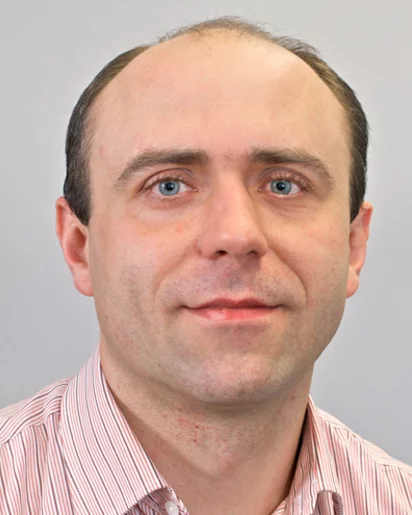CV
Vitaliy Guzenko is staff scientist within the Photon Science division. He studied physics at Taras Shevchenko National University of Kiev. In 2002 he obtained his PhD degree from RWTH Aachen University with a thesis on electrical transport in superconductor/2DEG weak links. For the further six years as a postdoc, he conducted his research at Research Centre Jülich addressing the collective effects in low-dimensional electron gases in III-V semiconductors. During this time he collected a valuable experience in micro- and nanofabrication techniques. Since 2008 he is the technical leader of e-beam lithography at Paul Scherrer Institute. His research is focused on development and optimization of the high-resolution lithography techniques. Since Aug 2019 he is leading ad interim the Nanotechnology and Cleanroom infrastructure group.
Institutional Responsibilities
Since 2008, as a technical leader of e-beam lithography, Vitaliy Guzenko has been involed into planing and building up the high-resolution e-beam lithography lab at LMN. In the following years, as the member of X-ray microscopy group, he was involved into development and establishing of variosus nanofabrication techniques with the focus on diffractive X-ray optics as well as improving the speed and efficiency of e-beam exposure. Providing nanofabricaiton services to external researcher groups and industrial customers belongs to his tasks as well. A special emphasis he has always put on exchanging the knowledge with new and experienced cleanroom users. Since 2019 he is acting as ad interim leader of the Nanotechnology and Cleanroom Infrastructure group and is involved into planning the new cleanroom in Park InnovAare.
Research
Vitaliy Guzenko's research is focused on developing nano- and microfabrication processes involving the high-resolution electron beam lithography. Especial interest is on manufacturing high aspect ratio nanostructures for efficient X-ray optics, boosting the throughput of the e-beam lithography system for the direct writing of the high-density nanostructure arrays as well as application of the gray-scale lithography for fabrication of blazed reflective X-ray optics or other functional 3D surfaces.
Publications
For the full list of publications please visit DORA
- Nanofabricated free-standing wire scanners for beam diagnostics with submicrometer resolution
G.L. Orlandi, C. David, E. Ferrari,V.A. Guzenko, R. Ischebeck, E. Prat, B. Hermann, M. Ferianis, G. Penco, M. Veronese, N. Cefarin, S. Dal Zilio, M. Lazzarino
Phys. Rev. Accel. Beams. 2020;23(4):042802 (10 pp.)
Results on fabrication and experimental characterization of wire scanners (WS) with submicrometer spatial resolution are presented. Independently fabricated at PSI and FERMI by means of nanolithography, the proposed WS solutions consist of 900 and 800 nm wide free-standing stripes ensuring a geometric resolution of about 250 nm. The nanofabricated WS were tested successfully at SwissFEL where low-charge electron beams with a vertical size of 400-500 nm were characterized. Further experimental tests at 200 pC confirmed the resilience to the heat-loading of the structures. With respect to conventional WS consisting of a metallic wire stretched onto a frame, the nanofabricated WS allow for an improvement of the spatial resolution from the micrometer to the submicrometer level as well as of beam invasiveness thanks to an equivalent reduction of the impact surface of the scanning stripe. The present work represents an important milestone toward the goal - that PSI and FERMI are pursuing - to realize a standard WS solution with minimal invasiveness and submicrometer resolution.
- Hard x-ray multi-projection imaging for single-shot approaches.
P. Villanueva-Perez, B. Pedrini, R. Mokso, P. Vagovic, V.A. Guzenko, S.J. Leake, P.R. Willmott, P. Oberta, C. David, H.N. Chapman, M. Stampanoni
Optica. 2018;5(12):1521-1524
High-brilliance x-ray sources (x-ray free-electron lasers or diffraction-limited storage rings) allow the visualization of ultrafast processes in a 2D manner using single exposures. Current 3D approaches scan the sample using multiple exposures, and hence they are not compatible with single-shot acquisitions. Here we propose and verify experimentally an x-ray multi-projection imaging approach, which uses a crystal to simultaneously acquire nine angularly resolved projections with a single x-ray exposure. When implemented at high-brilliance sources, this approach can provide volumetric information of natural processes and non-reproducible samples in the micrometer to nanometer resolution range, and resolve timescales from microseconds down to femto-seconds.
- Fabrication and characterization of high-efficiency double-sided blazed x-ray optics
I. Mohacsi, I. Vartiainen, M. Guizar-Sicairos, P. Karvinen, V.A. Guzenko, E. Muller, C.M. Kewish, A. Somogyi, C. David
Optics Lett. 2016;41(2):281-284
The focusing efficiency of conventional diffractive x-ray lenses is fundamentally limited due to their symmetric binary structures and the corresponding symmetry of their focusing and defocusing diffraction orders. Fresnel zone plates with asymmetric structure profiles can break this limitation; yet existing implementations compromise either on resolution, ease of use, or stability. We present a new way for the fabrication of such blazed lenses by patterning two complementary binary Fresnel zone plates on the front and back sides of the same membrane chip to provide a compact, inherently stable, single-chip device. The presented blazed double-sided zone plates with 200 nm smallest half-pitch provide up to 54.7% focusing efficiency at 6.2 keV, which is clearly beyond the value obtainable by their binary counterparts.


